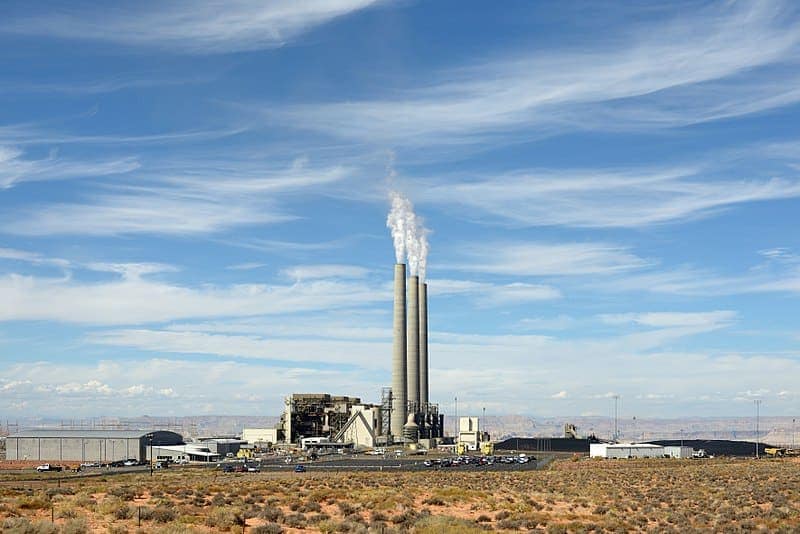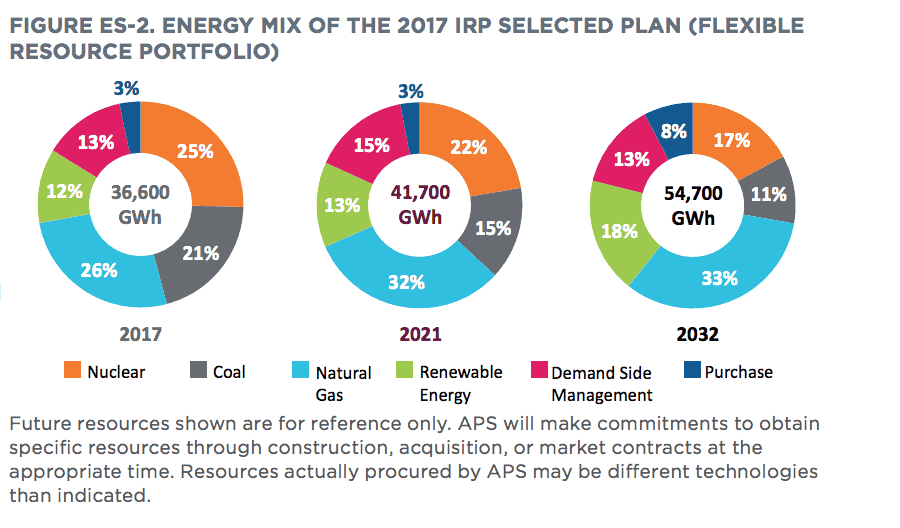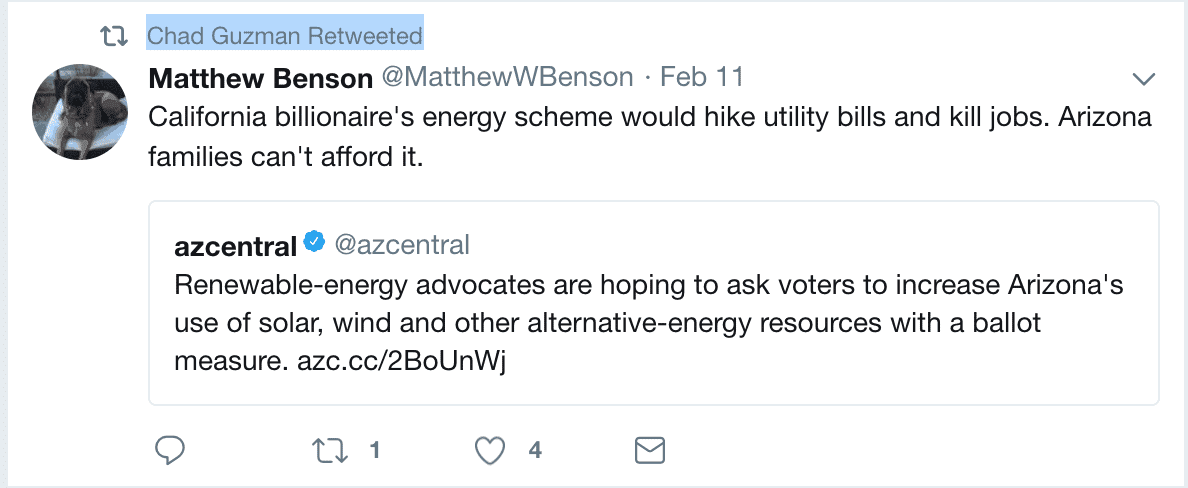APS will try to kill renewable energy ballot measure so that it can keep building gas plants

Arizona Public Service, the monopoly utility with a track record of spending millions to thwart pro-rooftop solar energy policy and candidates in Arizona, is poised to dip back into its coffers to kill a new effort that would require it to use more wind and solar energy.
On February 13, a coalition of public health, environmental and climate change advocates launched a campaign that seeks to place a ballot measure in front of voters that would require utilities like APS to produce 50% of their electricity from renewable sources by the year 2030. Arizona’s current law, the Renewable Energy Standard and Tariff (REST) requires APS to produce only 15% of its energy from renewable sources by 2025. It is one of the lowest such standards among Western states, which enjoy robust wind and solar resources.
In a statement yesterday, APS officially said that it was “not yet for or against” the initiative, according to KJZZ reporter Will Stone, but the rest of its statement left no doubt that the utility would fight the measure, as it asked loaded questions like “What measure does [the initiative] include to protect Arizona customers from higher electricity rates like those in California? What impact will it have on reliability in Arizona communities?” Those are likely to be a preview of months of fear-mongering that APS is readying.
Tweets and retweets from APS’ top lobbyists and PR officials offered similar previews:
Jessica Pacheco, APS’ top lobbyist:
Glenn, once again, says it perfectly! https://t.co/zDkfniEMgo
— Jessica Pacheco (@Jessica1Pacheco) February 12, 2018
Joe Ricciardi, Director of Employee Communications for APS:
I doubt they really care about AZ’s air quality… https://t.co/54YNZMkLgI
— Joe Ricciardi (@jhricciardi) February 13, 2018
Chad Guzman, another top APS lobbyist, retweeted this attack from the operative running one of APS’ political fronts, Matthew Benson:
APS wants to pour more of its customers’ money into more expensive gas plants
But why would APS oppose an effort to shift its generation mix to renewable sources, when it has been touting recent investments it’s made in solar power and batteries?
The answer lies in a document that APS filed with regulators last year known as the company’s “Integrated Resource Plan” or IRP. The IRP lays out what kind of electricity APS plans to generate, and what kind of power plants it wants to build over the next 15 years. Here’s the picture that tells a thousand words:

Currently, 12% of APS’ resources come from renewable sources. The utility says that by 2021, it will increase that only marginally, to 13%. By 2032 – two years after the ballot initiative would require it to be 50% renewable – APS is planning on powering only 18% of its energy mix with renewable sources.
The IRP makes clear that APS’s preference is to invest in gas-fired power plants, which enable it to spend more money – and make more of a profit – in larger chunks. Like all monopoly utilities, APS makes a profit not by beating competitors to offer services that its customers want, but by building infrastructure. Bigger infrastructure, like large gas plants, can mean more profit faster than more modular renewable investments.
APS could certainly change from the plans it made in the IRP filed 10 months ago, and it likely will now say that it plans on building more solar. But the utility considered a number of plans in its IRP, and every single one relied on significant increases in gas. Even APS’ “expanded renewables” plan resulted in only 22% renewable energy by 2032.
That’s far less than would be required by the ballot initiative, and also far less than other utilities are pursuing.
Xcel Energy, in nearby Colorado, is planning on being powered by 55% renewable power by 2023, a commitment that it says is based on the fact that renewable energy and batteries will be much cheaper than gas, contrary to APS’ implication in its statement that renewable energy will cause rates to go up. Xcel’s embrace of renewable energy also instantly debunks another false argument that APS previewed in its initial comment, which is that high levels of renewable energy threaten the reliability of the electrical grid. Xcel’s managers, which likely do not want a blackout any more than those at APS, have grown comfortable with the idea that high penetrations of renewable energy can provide just as electricity just as reliably as coal and gas.
APS’ preferred plan, from a friend on the ACC, has question marks
APS is likely to justify its opposition to the 50% renewable initiative by saying that it instead supports an alternate plan, recently proposed by Arizona Corporation Commissioner Andy Tobin, which would require it to power with 80% “clean” energy by 2050.
APS technically “withheld final judgment” on the Tobin plan, just as it technically did on the ballot initiative, but its intention to support the Tobin effort was just as transparent as its intention to kill the ballot measure. APS called Tobin’s plan a “bold, challenging vision for Arizona’s energy future.”
There are a host of reasons that climate and clean energy advocates should be skeptical if APS and other utilities try to use the Tobin plan as a convenient argument against the ballot initiative.
First, and perhaps most importantly, Tobin’s plan sets a target year of 2050, rather than the initiative’s target of 2030, allowing for years more of inaction by the state’s utilities.
Second, Tobin’s use of the word “clean” as opposed to “nuclear” is crucial. His plan includes nuclear energy as part of his 80% clean standard. That’s important, since APS is 26% nuclear powered now, via its Palo Verde Generating Station.
Nuclear plants around the country have been shuttering as they’ve failed to compete with renewable energy and cheaper gas, and Tobin’s plan would protect Palo Verde from that fate, as noted by Paul Walker, the director of a group called ConservAmerica, who lauded the plan on Twitter because it would “protect Palo Verde.” ConservAmerica has been a staunch supporter of APS’s agenda in the past. Tobin also spoke of “protecting some of our most important generating assets: Palo Verde Generating Station” when he rolled out the plan earlier this month.
Third, Tobin has not exactly been a strong check on APS during his time at the Corporation Commission. Tobin did send a letter to APS in 2017 questioning the utility’s use of gas, and he has been a fairly consistent advocate for energy storage, which plays a key role in his plan.
In a hearing earlier this month introducing his plan, Tobin would not commit to making the plan a binding mandate, as opposed to being only “directional” when asked by Commission Chair Tom Forese.
When it has counted, Tobin has voted consistently on behalf of APS’ interests. He joined three other commissioners in a 4-1 decision granting APS a rate increase that resulted in customers’ bills spiking. One APS customer said that the increase “is literally taking food directly out of my mouth.”
Tobin also voted against Commissioner Bob Burns’s efforts to force APS to open its books and become more transparent about its political spending.
Burns questioned whether the Tobin plan could be taken as a serious effort to grow renewable energy if it came from a commissioner who has shown such fidelity to APS’ interests in the past:
“If we want to move forward with a serious and significant clean energy plan, we are going to have to make decisions that may run contrary to the interests of APS,” Burns said. “It’s time this commission showed a willingness to do that.”
“Commissioner Tobin himself has led the efforts to keep the ACC as a group that is supportive of APS’ position,” Burns added pointedly.
The Energy and Policy Institute also reported that Tobin gave the keynote speech at a Scottsdale steakhouse dinner hosted by the American Gas Association last October – an odd speech for someone looking to earnestly grow renewable energy in Arizona at the expense of gas. Forese attended the gas industry’s conference as well.
APS has a war chest and a history of spending big to defeat solar energy
If the past two election cycles are any indication, APS will employ a variety of creative methods to spend its money to kill the initiative. The monopoly has already tucked away $3.2 million – $2 million in September, followed by another $1.2 million in December – for the 2018 election cycle in a group called “Arizonans for Sustainable Energy Policy.” The group has not reported receiving a dime from any “Arizonans” other than Pinnacle West Capital, APS’ parent company, as of yet. Benson is the group’s spokesperson.
In past years, APS has employed deception and confusion as some of its main weapons against ballot initiatives that it perceived as threats. When the rooftop solar industry threatened a ballot initiative in 2016, a consulting group with ties to APS hired a petition-gathering company to collect its own “survey” that looked like the solar petition, according to the Arizona Center for Investigative Reporting. Then the consulting group paid that firm rates that were far higher than market to sign a non-compete clause, jacking up the price of signature collection for the rooftop solar industry. (APS refused to confirm or deny its involvement at the time.)
In 2014, APS was rumored to have funneled millions of dollars to Save Our Future Now and the Arizona Free Enterprise Club. The organizations then spent money to support Republican candidates Tom Forese and Doug Little for the Arizona Corporation Commission, the state’s utility regulatory body. Forese and Little were dubbed the “pro-utility” candidates. APS and Pinnacle West refused to deny that the companies provided the money.
In 2013, APS spent hundreds of thousands of dollars through the 60 Plus Association and Prosper to turn Arizona ratepayers against solar net energy metering. It denied those expenditures before later backpedaling and acknowledging its involvement.
The Arizona Free Enterprise Club has already been attacking the new ballot initiative. One of the other earliest and most vociferous attackers of the ballot initiative has been the Arizona Chamber of Commerce and Industry, which has acknowledged spending money on behalf of APS and Southwest Gas to get their favored candidates elected to the ACC. APS’ top lobbyist, Jessica Pacheco, sits on the board of the Arizona Chamber.
Photo credit: Wikimedia Commons




